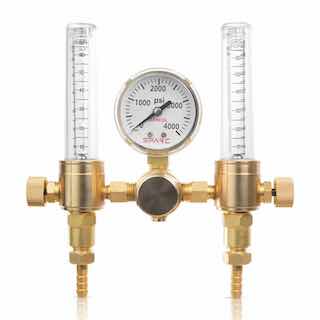lincoln electric arc 225 stick welder
by jody
(atl)

lincoln buzz box
I have had an 80A inverter / DC ARC welder for quite some time. It uses 110 right from a regular wall outlet and it does very well with 1/16 electrodes (typically 6013 and 7014) and matching soft steel parts. I can take two pieces of the same metal, prep them, run a bead, grind it off and it looks like the metal was never even cut.
I found that when I tried to weld dissimilar metals with an appropriate electrode for such use, the 80A box failed to perform all of a sudden. Harder steel in my mind would require more heat which requires more current but even when I turned the thing up to 80A it would use the 1/16 electrode way too quickly and just deposit a giant metal turd on the top of the steel.
So then I got some 3/32 electrodes (6011) and tried those. I went from 50A to 80A slowly and left it high but spent more time sticking to the steel than I did getting an arc. Then when I finally did manage to strike an arc the welds were not penetrating much and looked bad.
This made it obvious that my little 80A inverter is intended for similar or identical, softer metals in smaller gauges up to 5/16 or maybe even a little more thicker. It also became apparent that the electrode would have to be 1/16 to perform well.
Now I'll get into my electronics knowledge, make a statement and ask a question all in the same line.
I figured out that what was likely to be happening with this inverter is that the capacitors that stabilize the output and the power supply itself were running out of gas and my current was not consistent. Ohm's Law shows that there is a relationship and ratio between voltage and current. When voltage increases, current decreases and when voltage decreases, current increases. Now there are other variables of course that will effect the results either way but this is how things work with voltage and current.
Forgive me if you know all of this, I am not patronizing you but rather just presenting my "case" so that I can ask the question and you will know where it's all coming from.
So my inverter rectifies AC and outputs DC and the current adjustment is tied into the range of voltage at the output. More voltage... less current, less voltage... more current. But if the outlet being used is connected to 250feet of Romex in the wall and then you have an extension cord adding another 25 feet there is already likely to be a loss of 5-10 volts under load. As the line-losses are dynamic with the load, when I try to strike a larger electrode it draws the whole thing down and it sticks because the current dipped out as the power supply lost voltage on the line-side. This is where the other variables to Ohm's Law in a given situation come into play.
If I reduce voltage on the secondary side or output, I will see more current or more will be "seen" by the output side of the device. But If I have bad line power on the primary side of the device or at the input and lose voltage, the already current-limited line from the breaker panel sees more current and that causes a dynamic increase in power loss and heat.
So I recently got my hands on a Lincoln Electric ARC-225 welder and just last night after I cleaned it up and made a loom for power, I connected it for the first time since I brought it home almost two weeks ago.
Ohm's Law rides again... stepping down to a 24-74 volt output range from 240 volts at input makes everything easier where producing more current is concerned because the difference is much greater between where you started on the line-side and where you ended up at the output.
I got my helmet and gloves out, laid my slag-hammer and brush on the bench and pulled out a couple of 3/32 6011 electrodes. Then I dug an old rusty piece of hard steel shaft that I had used for practice welding right when I started two years ago out of a scrap pile and put it on he bench.
I clamped the ground to it, put a rod in the stinger and struck an arc and that damn thing did exactly what it was supposed to do. I got nice slag that flaked right off and a nice looking, consistent bead that showed the pattern of my "working" it whether I pushed it as I moved or weaved it... whatever. It was a total success and now I finally have the current to weld some bigger projects which will be important here pretty soon.
My question is simple and as I am writing this message it becomes obvious that this was more about telling a story than it was about asking something. But have you found that the welder itself is more to blame for inconsistency or has it been the power supply to the equipment? The welders are basically big transformers with some other stuff built around them or they can be high capacity switching power supplys as well but they all vary voltage, current and in some cases frequency (hz) at the output.
It seems to me that a weak line-side would cause most of the trouble.
In any case... I am really excited to have this welder. It's nothing fancy but like I said in my last message, these simple ARC welders are what built the world as we know it up to a certain point and they still get used for structural welding in the most modern construction.
I talked to an older man who I see at a gas station a lot and always say hello to the night I was taking this welder home. The Lincoln was in the passenger seat of my 1980 Jeep CJ5 with the seat belt around it and the man noticed it and asked me about it. I told him how I was working a deal out with someone I do some work for and he just smiled and told me that his dad had used that exact welder for years and that he had gotten it after he died and he had used it for years and still does.
He does have a MIG as well now but he still uses that old ARC welder for certain things. He told me a story about being on a ship when he was in the NAVY and talking to a ship-welder who was working on one of their vessels. AT the end of the story he told me tat the guy said "You give me the right rod and I can weld a telephone pole to a gnat's ass."
I want to be that good. It seems like I just took a big step forward. Now that my tool won't limit me I can really see what I am actually doing. I'll keep the little 80A inverter for going to someone's house to fix their BBQ or doing the same kinds of small things here. It really is very useful.
Cheers,
Lance P.S. If you want to publish any of this please do.
-----------------------------------------------------------------------
lance,
that was a very interesting email.
i am no electrician, but what i do know is exactly what you have learned...those lincoln welders are tough as nails and are tried and true.
your little inverter will be an asset to you as well ..with a tank of argon and tig torch, you could probably do some scratch start tig welding with it for really thin steel and stainless.
best of luck to you and thanks for this email.
i will definitely post it
best regards,
jody
--
Jody Collier
https://www.weldingtipsandtricks.com














